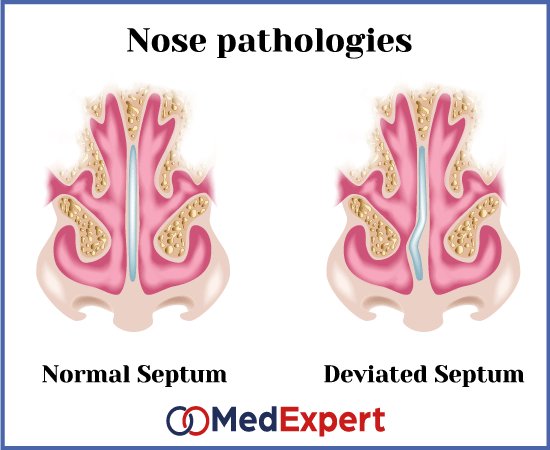DEVIATED NASAL BONES AND NASAL SEPTUM
One of the most common abnormalities of ENT-organs is deviation of nasal septum. Deviated septum symptoms include nasal congestion and breathing problems. Deviated nasal septum treatment involves surgical correction of the abnormality. Below you may find more detailed information about the nature of this malformation, as well diagnostic services and deviated nasal septum treatment options.
A deviated septum is a condition whereby the nasal septum (the cartilage and bone that divide the nasal cavity in half) is crooked, significantly off centre or makes breathing difficult. Approximately 80% of people have a misaligned nasal septum but only in a case of severe misalignment does one find it difficult to breathe.

CAUSE OF A DEVIATED NASAL BONES AND NASAL SEPTUM
This comes about as a result of trauma or injury to the nose in some people while others may occur from birth.
DEVIATED SEPTUM SYMPTOMS
- Nasal congestion
- Breathing difficulties
- Repeated sinus infections
- Nosebleeds
- Facial pain
- Headaches
- Postnasal drip
- Loud breathing and snoring
A deviated septum can also lead to sleep apnea which can cause a person to stop breathing while they sleep. This is a serious condition.
DEVIATED NASAL SEPTUM TREATMENT OPTIONS
SEPTOPLASTY
This is a surgical procedure that is carried out in order to straighten the nasal septum. During this process, the surgeon works through the inside of the nose by making a small incision in the septum after which any excess bone or cartilage is removed to even out breathing space of the nostrils.
FUNCTIONAL SEPTORHINOPLASTY
This is a surgical procedure which targets the structure of the nasal skeleton. This procedure maybe combined with septoplasty to improve the appearance of the nose. It is an outpatient setting which is performed under general anaesthesia and only takes one and a half hours. To stabilize healing, post-surgery internal splints maybe inserted into the nose.
DIAGNOSING DEVIATED NASAL BONES AND NASAL SEPTUM
- Physical examination: Questions about symptoms are asked by the doctor followed by an examination of the nose with the use of a nasal speculum which is designed to widen the nostrils.
- Nasal endoscopy: Nasoendoscopy is a minimally invasive, medical procedure carried out to diagnose any nasal conditions. It helps to examine the interior surfaces of the nose and allows visualization of its cavities not possible by standard examination. The procedure is performed with the help of a nasal endoscope which is a medical device consisting of a thin, rigid tube with fiberoptic cables to light-up the inside of the nose. The endoscope is then connected to a light source and a video camera to project magnified images on a screen. During the procedure your doctor may capture or record the images for further documentation.



